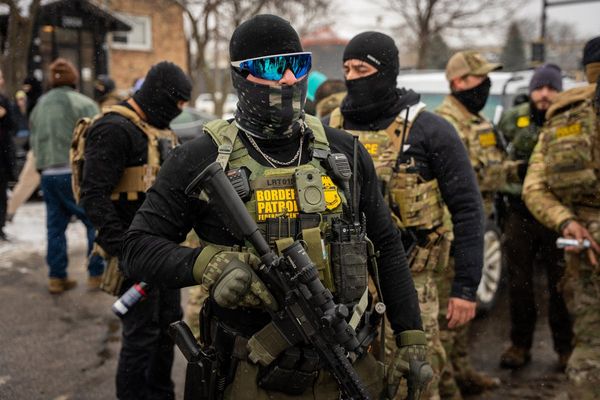
China’s recent military drills near Taiwan were a substantive and “war-like” escalation on those conducted last August despite not including any missile launches, some analysts have said.
The drills were launched in retaliation to Taiwan’s president, Tsai Ing-wen, traveling to the US and meeting the US house speaker, Kevin McCarthy. Beijing, which claims Taiwan as a province despite that being rejected by its government and people, declared the meeting a provocation by Taiwan “separatists”, enabled by the US.
Shortly after Tsai landed in Taipei, Beijing announced the almost immediate start of three days of military drills.
The People’s Liberation Army (PLA) and Chinese state media described them as practising encirclement of the island, and pre-invasion attacks. They carried out drills or simulated direct strikes on Taiwan from the sea, air and China’s mainland, and conducted multiple incursions over the median line – the de facto border on international waters of the Taiwan Strait. Reuters reported a standoff of 10 ships from each navy at the line.
It was the largest show of force since the drills launched in response to McCarthy’s predecessor, Nancy Pelosi, visiting Taipei in August. Those exercises, which took place over eight days, included 11 missiles fired over Taiwan into the sea, and blockade-style tactics that disrupted air and sea traffic.

But some military analysts have said that this weekend’s drills were more specific about China’s intent to annex Taiwan, demonstrative of a pre-invasion attack, and raised the risk of miscalculation and escalation.
“[The PLA] are getting less loud and more muscular in the way they shape their signalling,” said Alessio Patalano, professor of war and strategy in east Asia at King’s College London.
“A big show of force raises the tolerance of what is normal to accept in a military sense. But specific tailored activity is indicative of clear intent and that’s the more troubling. These ones, smaller though they were, reflected a specific configuration that more clearly identifies steps just short of an invasion of Taiwan.”
On Monday, before the drills had finished, Taiwan’s foreign minister, Joseph Wu, told Bloomberg he believed they were similar in intensity. A former legislator turned commentator, Guo Zhengliang, told local media that the drills may not be “as obvious” as last August, but seemed “closer to the actual state of war”. Other Taiwanese military figures and analysts pointed to the deployment of the Shandong aircraft carrier as cause for concern. Chang Yen-ting, a retired air force lieutenant general, told CNA the eastern waters were now clearly under serious threat.
From Saturday morning until Monday evening, the PLA sent 232 warplanes towards and around Taiwan, inside its air defence identification zone. The ADIZ is a large area far beyond sovereign territory, monitored for defence purposes. This compared with 167 during the Pelosi drills, although higher activity was recorded for days before and afterwards, and set a new normal for the months to come.
There was a huge diversity among the aircraft reported inside the ADIZ this time. Monday’s cohort included 13 different types, including five models of fighter jets, a reconnaissance drone, transport planes, nuclear-capable bombers, and refuelling aircraft.
The aircraft carrier Shandong, which led drills in the western Pacific Ocean for the first time, launched J-15 fighter jets towards Taiwan hundreds of times to simulate direct strikes on the island.
Open source information has suggested many of the ships this weekend sailed inside Taiwan’s 24-nautical mile contiguous zone where they were confronted by Taiwan’s navy, but did not enter its sovereign waters.
The movements of the Shandong-led carrier strike group – first seen sailing past southern Taiwan on Thursday, in hindsight an early clue of the drills to come – drew in other international parties. Japan confirmed it had scrambled its air force in response, and the US Nimitz aircraft carrier stayed in the region.
Blake Herzinger, a research fellow at the USSC foreign policy and defence programme, noted that no more than 12 ships were reported by Taiwan in the ADIZ on any one day, and a real encirclement contingency would probably see “20 times that”. He also said the several hundred fighter jet takeoffs from the Shandong over three days revealed a big advancement for the PLA from even five years ago, but was still fewer than a US carrier could do in a day.
“But what we saw is a bit more realistic, comprehensive, pulling together more capabilities and highlighting some things they might intend to do in blockade or invasion,” Herzinger said.
“I thought the inspection mission was more significant in my mind,” he said, referring to a three-day patrol mission announced by Chinese maritime authorities prior to the drills. China’s coastguard claimed the right to board and inspect all vessels in the Taiwan Strait. Taipei ordered Taiwanese vessels to refuse, and observers warned any attempt could see worrying escalation.
“That [mission] was a cleverer move, if we expect them to continue trying to erode Taiwan and what Taiwan is, asserting their ability to control maritime traffic – much like they do in the South China Sea.”
Herzinger said he expected to see it again, “to the extent China thinks they can get away with it”. But, noting Taiwan’s vociferous pushback, “that sets up a scary confrontation”.
The full picture of these exercises isn’t clear. The PLA does not release details beyond its propaganda videos and state media articles. Japan only reports movements that have implications for its country. And Taiwan’s defence ministry data only covers the ADIZ (likely not capturing all the J-15s launched from outside it), and lacks clarity.
Taiwan’s defence ministry altered the way it reported ADIZ detections during the August 2022 drills. Since Taiwan’s reporting mechanism was changed, the daily reports now are sometimes ambiguous on whether aircraft crossed the median line or if they were just detected in an area of the ADIZ to its east.
The ministry did not respond to requests for further clarification.
Monday’s data suggested that the day had seen one of the highest numbers of PLA planes sent towards Taiwan in years, perhaps the highest. But the way detections are reported makes it is impossible to be sure. Taiwan also does not give location data for the PLA navy vessels, unlike Japan’s ministry. Some analysts have expressed concern that without clear data, they cannot fully assess changes to the PLA’s level of aggression.
Crossings of the median line have long been considered significant. Beijing tacitly respected the line until September 2020, and it used to reserve crossings for when it wanted to significantly respond to something it considered an act of provocation. After the August drills, crossings became much more common.
Herzinger said it was important to keep an eye on the PLA’s attempt to normalise median line crossings, and “erode these things that traditionally kept the two sides apart or made miscalculation less likely”.
Patalano said that for all the questions, the weekend’s drills were clearly more specific, and targeted. They didn’t indicate China was ready to invade – and external assessments don’t believe they are yet. But they did send a strong message.
“I do think they’re reaching a level of confidence whereby they think they are within grasp if they need to do so, of biting pieces of Taiwan.”







